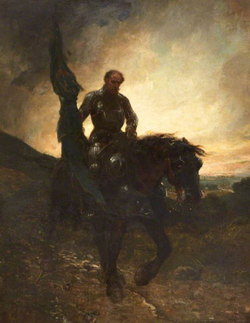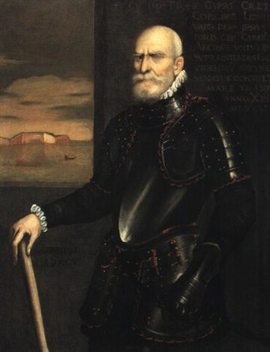Edmond of the Blackwald
|
|
Contents
Early Life
Born on the 3rd of Sigismund’s End, 1819, in the far reaches of the Arentanian Mountains of the Holy Orenian Empire to Joachim de Rouen and Lillian Barbanov, the life of Edmond de Rouen was not supposed to be significant. As the son of a petty scion of the House of Ashford de Bar, a family whose already-petty prestige had been diminished by their participation in the failed Sedan Rebellion, the early years of the young Edmound were marked by uncertainty as he and his family bounced around the various courts of sympathetic friends. His mother’s death in 1820 only furthered the hardship the boy would face in his early years.With his father’s death in 1835, the young Edmond was now left without family and with few friends. However, that is not to say he lacked entirely. Fortunately, Olivier de Savoie, an old friend of his father, took Edmond as his own and brought him to the lands of Sutica. Under Olivier’s tutelage, the boy learned the basics of combat and the arts of warfare. While the rest of his education was notably lacking, it would not matter greatly over the course of his life. It would be his skill at arms that defined him from here on out.
Service to Savoy
With Olivier’s ascension to become Prince of Savoy in 1836, Edmond de Rouen was quickly tapped to become one of the new prince’s principal commanders. Now an anointed knight and Baron of Blackwald, Sir Edmond was a crucial part in the national strengthening of Savoy and its rapid ascension to become one of the the leading states in Almaris. While Savoy generally knew peace during this time, Sir Edmond did see his first combat while conducting successful anti-piracy operations along the principality’s northern coast. The Aster Revolution brought Sir Edmond his greatest notoriety, or fame, depending on how one views the situation. During the early days of the great revolution against Emperor Philip II, it was Sir Edmond that was contracted to kill Philip Aurelian, Duke of Adria and Crown Prince of the Empire, by the latter’s mistress. He would later confess to this grave sin and seek forgiveness. As a part of his penance, he took to telling his tale to caution others of the evils of politically-driven murder. While Sir Edmond had never been a great lover of the Holy Orenian Empire, he followed many of the Savoyards in joining the Empire. He found common kinship with Philip III and Anastasia, and loyally fought for them in the Eastfleet War, even after Prince Olivier’s death in the Siege of Southbridge. Proving himself a capable, competent commander, he led the Imperial-Savoyard forces to numerous victories, and played a crucial part in the Battle of the Lower Petra as a member of the Emperor’s personal guard.
The Flight of San Luciano
Sir Edmond’s most notable exploit during the Eastfleet War came with his famous “Flight of San Luciano.” Although he was in loyal service to the Empire by this point, his true love still lay with his homeland in Savoy. As the principality jockeyed between the brothers Leufroy and Olivier, the former a staunch supporter of the Empire and the latter preferring neutrality, Sir Edmond cast his lot with the younger Leufroy and led a contingent to San Luciano to assert the young prince’s claim. However, when he and his men arrived, a great host from the Tripartite Accord surrounded the city. Leufroy attempted to lead a breakout with his inferior forces, but was cut down with his soldiers. Leading a paltry unit of one hundred men, Sir Edmond found himself powerless as nearly eight thousand Tripartite soldiers stormed the walls of San Luciano and cornered the final supporters of Leufroy in the city center. However, miraculously, Sir Edmond was able to lead his force in a desperate charge to escape the city. Breaking through the Tripartite lines, he and his small force were able to make their way through the barracks and out a secret entrance. Not a single man had been killed or seriously wounded. Soldiers from both sides are said to have remarked that Sir Edmond had certainly been blessed by God that day, for the odds of he and his men escaping alive were next to none.
Service to Oren
For the remainder of the war, Sir Edmond fought valiantly for the Imperial cause, and quickly grew to become one of the Emperor’s most trusted commanders. He played a crucial part at the Battle of Haverlock Fields and the Battle of Ferry’s Folly, where his expert grasp over cavalry maneuvering was invaluable to the two victories. With his heightened influence, he made common cause with the Emperor’s youngest son, Prince Frederick, and soon entered the personal service of the young Count of Mardon. In this capacity, he took command of the prince’s personal guard, leading it during the failed Battle of Eastfleet, though controversially he and the men of Mardon saw no combat there. Sir Edmond continued to serve Prince Frederick through the Brother’s War, where he was the overall commander during the Battle of Reutov that saw the rival Emperor Peter IV taken captive. He further showed merit at the Battle for New Providence, where he fought ably and was said to be an inspiring presence on the field of battle. As the Holy Orenian Empire gave way to the Kingdom of Oren, Sir Edmond sat beside King Frederick as one of the latter’s closest confidants and premier vassals.
In 1878, at the age of fifty nine, he was wed for the first time to Regina de Savoie, the daughter of the late Leufroy de Savoie, the same man that Sir Edmond had fought for many years ago. Despite being nearly thirty years apart in age, the two got along amicably and had their first son, Lucien, in 1879. A second, Ferdinand, came in 1881. Sir Edmond continued to serve King Frederick loyally up through the Harvest Revolution, where he was one of the few remaining loyalists who stood by his liege’s side. However, with Frederick’s defeat and death, and Sir Edmond’s own near-execution, the aged knight took he and his family to the Commonwealth of Petra, joining many refugees fleeing the advancing Harvest Confederation. It was in Petra that Sir Edmond found peace for many years, where he spent his time raising his family and tended to a small estate on the banks of the River Petra.
Death
The final act of Sir Edmond’s long, storied life came with the Petran Civil War. Finding himself on the side of the rebel forces under Prince Constanz, the experienced Sir Edmond was named field marshal in the fight against Archduchess Renilde’s rule. While he, as usual, fought valiantly and led his men with skill, the army he commanded was inferior in composition to the trained knights and seasoned mercenaries that made up Archduchess Renilde’s ranks. At the Battle of Valfleur he and his men were decisively beaten. For his role in the conflict, Sir Edmond was ingloriously stripped of his lands and titles and sentenced to exile.
However, the old knight, now nearly a century old and dying, made his way to Petra with his family for the last time. Under the cover of a cloudy night, he was carried to the banks of the River Petra, where he was given his last rites and confession by the Bishop of Buron. It is said that moments after he gave his final breath, surrounded by only a few family members and the bishop, moonlight broke through on the skyless night, piercing the clouds and illuminating the man’s gauntlets that had seen a thousand battles. The Bishop of Buron was shocked and himself claimed that the act must have been a sign of God’s blessing onto the soul of the aged warrior as he passed on to the next life. Thus ends the short tale of Sir Edmond de Rouen.

Issue
| Name | Birth | Death | Marriage | |
|---|---|---|---|---|
| Osmond Ashes | 1851 | 1899 | Octavia Carolicz | Bastard son of Edmond I |
| Lucien Edmond | 1879 | Living | Adelheid Jrent | First legitimate issue of Edmond I |
| Ferdinand Leufroy | 1881 | 1921 | Leopoldina of Ulmsbottom | Thirdborn child of Edmond I |

